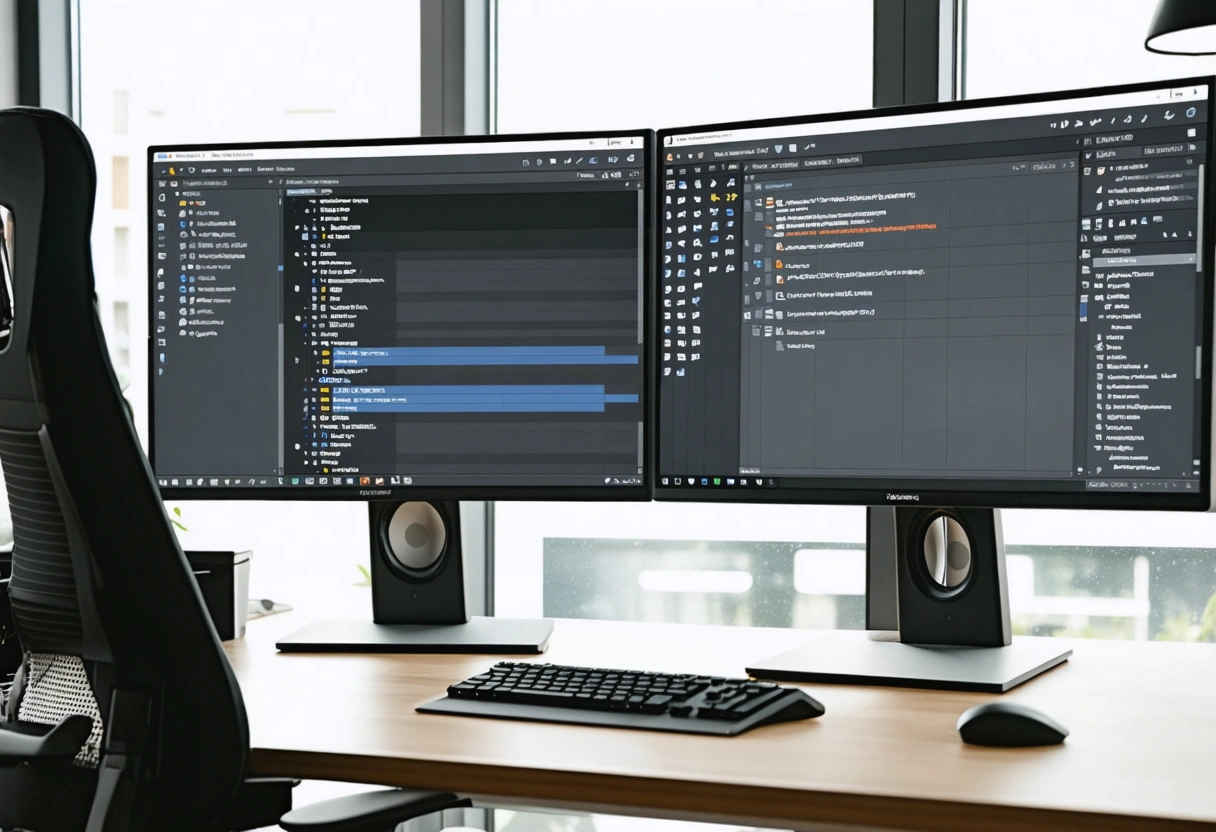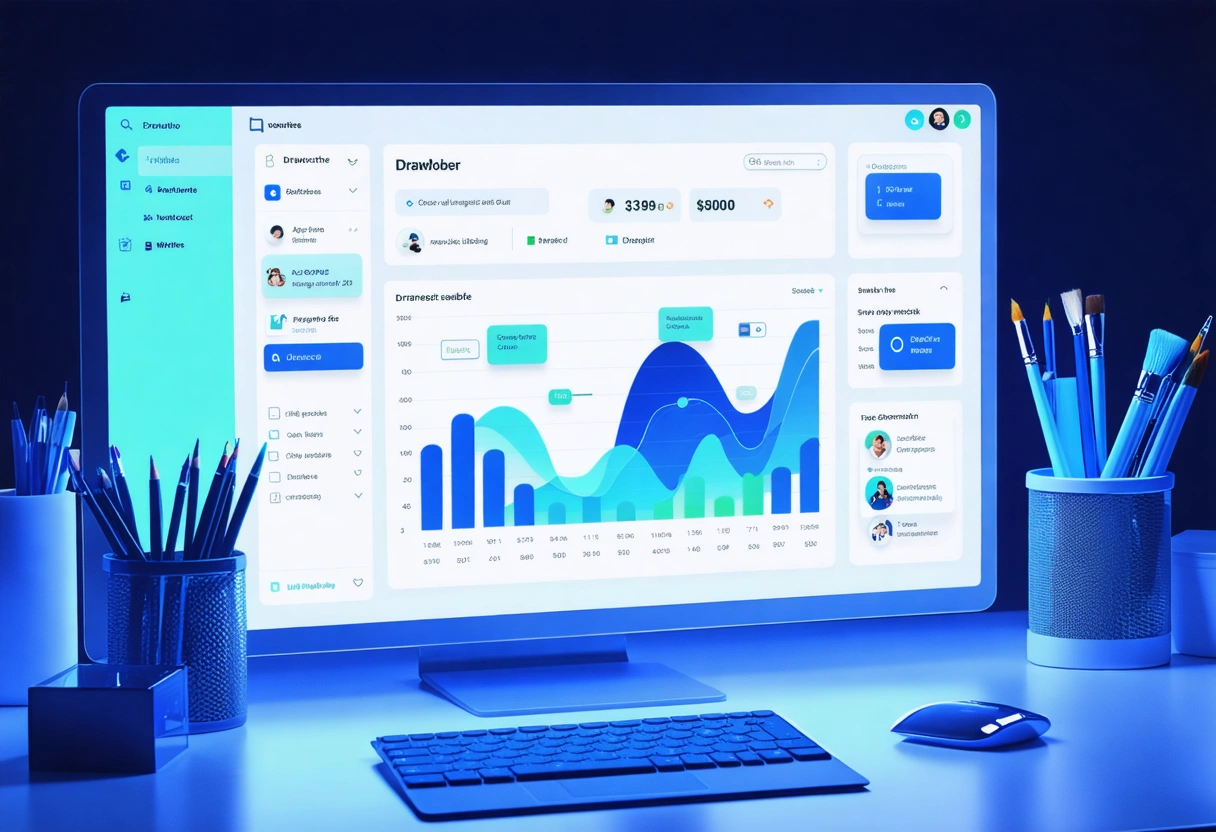
by Guru IS | Sep 22, 2025 | Security
Securing Your Online Reputation: Best Practices for Safeguarding Your Brand
In the digital era, your brand’s reputation is one of its most valuable assets. Whether you’re a global corporation, a small business, or a personal brand, the way you are perceived online can have a profound impact on your success. Negative reviews, misinformation, data breaches, or even a single ill-advised social media post can have long-lasting consequences. This comprehensive guide will walk you through the critical best practices for securing your online reputation and ensuring your brand remains trusted and resilient in an ever-evolving landscape.
Reputation management is no longer a reactive measure. Proactive strategies are essential for minimizing risk and maintaining a positive brand image. By understanding the threats, deploying robust monitoring tools, implementing effective response protocols, and leveraging security best practices, you can safeguard your brand from potential reputational harm. Let’s delve into the multifaceted world of online reputation security and discover actionable insights to protect your brand’s digital presence.
Understanding the Landscape of Online Reputation Risk
The first step in reputation protection is recognizing the myriad threats that exist in the digital sphere. Brands face risks from a wide range of sources, including disgruntled customers, malicious competitors, cybercriminals, and even well-meaning employees who may inadvertently share sensitive information. With the proliferation of social media platforms, forums, review sites, and news outlets, information travels faster and further than ever before.
In addition to direct attacks such as insider threats and cyber incidents, brands must also contend with indirect risks such as misinformation, fake news, and coordinated smear campaigns. A single negative story can quickly go viral, impacting public perception and eroding customer trust. Understanding the types of risks your brand faces is foundational to building a robust reputation defense strategy.
Building a Reputation Management Framework

A proactive reputation management framework integrates monitoring, response, and security protocols to minimize risk and enable swift action when issues arise. The framework should be tailored to your brand’s unique needs, industry, and risk profile. Start by defining your brand values and key messaging. Ensure that all communications, both internal and external, reflect these principles consistently.
Assign clear roles and responsibilities within your organization for reputation management. This includes designating spokespersons, setting up incident response teams, and establishing escalation procedures for various types of reputation threats. Regular training and awareness programs help ensure that all employees understand the importance of safeguarding the brand’s image and know how to respond appropriately when challenges occur.
Continuous Monitoring and Early Detection
Continuous online monitoring is a cornerstone of reputation security. Utilize advanced tools and services to track brand mentions, reviews, media coverage, and social media conversations in real time. Platforms like Google Alerts, Mention, and Brand24 can help you stay informed about what’s being said about your brand across the internet.
Don’t limit your monitoring to your own channels. Watch for mentions on third-party sites, blogs, forums, and even the deep web. Early detection allows you to address emerging threats before they escalate. For example, by identifying negative reviews or inaccurate information early, you can reach out to the source, provide corrections, or respond publicly to demonstrate your commitment to transparency and customer satisfaction.
Responding Effectively to Negative Content

No brand is immune to criticism or negative feedback. How you respond, however, can make or break your reputation. Develop a clear response protocol that emphasizes empathy, transparency, and accountability. Avoid defensive or dismissive language. Instead, acknowledge concerns, provide factual information, and outline steps being taken to address any issues.
In cases of misinformation or malicious content, consider working with legal counsel to determine if removal or takedown requests are appropriate. However, focus primarily on constructive engagement. A thoughtful, measured response can often turn a critic into a supporter and demonstrate to the broader public that your brand values integrity and customer care. For more on effective crisis communication, check out this in-depth guide from Inc. on defusing a social media crisis.
Leveraging Cybersecurity to Protect Your Brand
Cybersecurity and reputation management are deeply intertwined. A data breach or successful cyberattack can significantly damage trust and credibility. Implement robust cybersecurity measures, including strong password policies, multi-factor authentication, regular software updates, and employee training on phishing and social engineering threats.
Monitor for potential brand impersonation or phishing attacks. Cybercriminals frequently create fake websites, social media accounts, or email campaigns that mimic legitimate brands to deceive customers or steal sensitive data. Utilize tools such as Google’s Safe Browsing and anti-phishing technologies to detect and mitigate these threats. The FTC’s guide on recognizing phishing scams offers actionable tips for organizations and individuals alike.
Managing Social Media Presence Responsibly

Social media platforms are powerful tools for brand building but can also be sources of reputational risk. Maintain a consistent, professional presence across all official channels. Implement strict access controls and approval workflows to prevent unauthorized or inappropriate posts. Regularly audit your social media accounts for inactive profiles, outdated information, or security vulnerabilities.
Establish clear social media guidelines for employees, especially those who manage brand accounts. These guidelines should cover acceptable content, response protocols, and procedures for reporting issues. Encourage employees to use privacy settings and avoid sharing sensitive company information on their personal accounts. For more comprehensive advice, see this step-by-step guide to creating social media guidelines.
Encouraging Positive Engagement and Transparency
One of the best defenses against reputation threats is a strong foundation of positive engagement. Encourage satisfied customers to leave reviews, share testimonials, and participate in brand advocacy programs. Highlight positive stories, case studies, and customer success stories across your digital channels.
Transparency is equally important. When mistakes occur, own up to them and communicate openly about corrective actions. This builds credibility and fosters long-term loyalty. Consider publishing periodic transparency reports or updates to keep stakeholders informed about your brand’s commitment to ethical practices and data security.
Legal Considerations and Intellectual Property Protection

Protecting your intellectual property (IP) is vital to maintaining brand reputation. Register trademarks, secure relevant domain names, and monitor for unauthorized use of your brand assets. Infringement or misuse of your IP can lead to confusion, reputational harm, and legal disputes.
Work with legal professionals to develop a strategy for enforcing your rights and addressing violations. Stay informed about the latest developments in digital copyright and trademark law. The World Intellectual Property Organization’s resource on IP and reputation contains valuable insights on this subject.
Preparing for and Managing Reputation Crises
No matter how diligent your brand is, crises can still occur. Prepare a comprehensive crisis management plan that outlines roles, responsibilities, communication channels, and key contacts. Conduct regular simulations or tabletop exercises to ensure your team is ready to respond quickly and effectively.
During a crisis, act decisively and communicate regularly with stakeholders. Provide updates as new information becomes available and be transparent about the steps being taken to resolve the situation. A well-executed crisis response can mitigate damage and even enhance your brand’s reputation for responsibility and leadership. Explore the Ready.gov crisis communication planning framework for detailed planning guidance.
Monitoring and Evolving Your Reputation Strategy

The digital landscape is constantly changing, and so are the threats to your brand’s reputation. Regularly review and update your reputation management strategy to reflect emerging risks, new technologies, and evolving consumer expectations. Stay informed about industry best practices and adapt your approach as needed.
Solicit feedback from customers, partners, and employees to identify areas for improvement. Use analytics and reporting tools to measure the effectiveness of your reputation management efforts and adjust your tactics accordingly. The goal is to build a resilient, adaptable brand that can withstand challenges and maintain a positive, trusted presence online.
Proactive Reputation Security for Long-Term Brand Success
Safeguarding your online reputation is an ongoing process that requires vigilance, adaptability, and collaboration across all levels of your organization. By understanding the risks, implementing robust monitoring and response protocols, leveraging cybersecurity best practices, and fostering positive engagement, you can protect your brand against reputational threats and build lasting trust with your audience.
Remember, reputation security is not just about damage control. It’s about proactively shaping perceptions, nurturing customer relationships, and demonstrating your brand’s commitment to integrity and excellence. With the right strategies in place, your brand will be well-equipped to navigate the complexities of the digital world and thrive for years to come. For further reading on holistic approaches to online reputation management, visit this comprehensive guide to online reputation management.

by Guru IS | Sep 17, 2025 | Website Development
How Rapid WordPress Website Builds Can Propel Your Business Forward
In the fast-paced digital landscape, having a compelling and functional website is no longer optional for businesses that want to thrive. The need for speed has become paramount, and rapid WordPress website builds have emerged as a game-changing solution for companies eager to establish their online presence without unnecessary delays. Leveraging the power of WordPress, businesses can launch sites in record time, allowing them to capitalize on market opportunities, outpace competitors, and adapt swiftly to changing customer needs.
This article delves into the transformative benefits of rapid WordPress website development, unpacks the strategies that enable quick site launches, examines real-world success stories, and explores how businesses can optimize their approach for maximum impact. Whether you are a startup, a growing business, or an established enterprise seeking digital agility, understanding the potential of rapid WordPress builds could be the catalyst your business needs to accelerate growth.
Why Speed Matters in Website Development
The digital world rewards those who move quickly. In an environment where consumer preferences shift rapidly and technological trends evolve overnight, a slow website launch can mean missed opportunities and lost revenue. Time-to-market is a critical factor in business success, and the ability to launch or update a website swiftly enables businesses to stay relevant and responsive.
Moreover, website usability and user experience are directly influenced by how effectively and efficiently a website is built. A rapid build process doesn’t mean cutting corners; rather, it means leveraging best practices, proven tools, and agile methodologies to deliver a high-quality site in less time. This speed gives businesses the flexibility to test new ideas, pivot strategies, and capture market attention before competitors do.
The Power of WordPress for Rapid Website Builds
WordPress is the world’s most popular content management system, powering over 40% of all websites globally. Its widespread adoption is no accident—WordPress offers an unparalleled combination of flexibility, scalability, and user-friendliness, making it the platform of choice for rapid website development. The platform boasts an extensive ecosystem of themes, plugins, and integrations, allowing developers to build feature-rich websites with minimal custom coding.

One of the key advantages of WordPress is its modular architecture. By utilizing pre-built plugins and themes, businesses can dramatically reduce development time. This means essential features like contact forms, e-commerce capabilities, SEO tools, and social media integration can be implemented with just a few clicks. For businesses with unique requirements, WordPress also supports robust customization through child themes and custom plugins, ensuring that rapid builds don’t come at the expense of brand identity or functionality.
Furthermore, WordPress’s intuitive dashboard empowers non-technical users to manage content, update images, and make changes on the fly. This reduces reliance on developers for ongoing maintenance, freeing up resources that can be reinvested into marketing, product development, or customer service.
Benefits of Rapid WordPress Website Development
-
Faster Time-to-Market: Rapid WordPress builds enable businesses to seize opportunities as they arise. Whether launching a new product, promoting a time-sensitive campaign, or responding to market shifts, speed is a decisive advantage.
-
Cost Efficiency: By streamlining the development process and leveraging pre-existing assets, businesses can significantly reduce initial design and development costs.
-
Agility and Flexibility: Rapid builds allow for quick iterations, enabling businesses to test, learn, and adapt based on real user feedback and analytics.
-
Competitive Advantage: Being first to market often means capturing a larger share of traffic and establishing brand authority ahead of slower-moving competitors.
-
Reduced Technical Debt: Utilizing well-maintained plugins and adhering to WordPress best practices minimizes the risk of accumulating outdated code or security vulnerabilities.
Strategies for Achieving Rapid WordPress Website Builds
Successfully launching a WordPress website quickly requires more than just picking a template and going live. It demands a strategic approach that balances speed with quality and scalability. Here are the core strategies that can help businesses achieve rapid builds without compromising on excellence:
1. Define Clear Objectives and Requirements: Before any development begins, stakeholders should align on the website’s goals, target audience, and essential features. Creating a concise project brief ensures everyone is on the same page and eliminates scope creep, which can delay the launch.
2. Leverage High-Quality Themes and Page Builders: Premium WordPress themes and page builders like Elementor or WPBakery allow for rapid prototyping and design. These tools offer drag-and-drop functionality, pre-designed templates, and extensive customization options, enabling developers and marketers to build visually appealing sites in hours rather than weeks.

3. Utilize Essential Plugins Wisely: Plugins can save significant development time, but overusing them can lead to bloat and security issues. Select only reputable, well-supported plugins for core functionalities such as SEO optimization, security, and e-commerce.
4. Implement Agile Development Practices: Adopting an agile approach allows teams to work iteratively, prioritize high-impact features, and launch a minimum viable product (MVP) quickly. Additional enhancements can be rolled out post-launch based on user feedback and analytics.
5. Optimize Hosting and Deployment: Choosing a managed WordPress hosting provider can streamline deployment, improve performance, and automate updates. Providers like WP Engine and Kinsta offer staging environments and one-click backups, further accelerating the development process.
Case Studies: Rapid WordPress Builds in Action
Many businesses across various industries have harnessed the power of rapid WordPress website development to achieve their goals. For instance, during the height of the COVID-19 pandemic, numerous brick-and-mortar retailers needed to transition to online sales within days. By leveraging WordPress and WooCommerce, these businesses were able to launch fully functional e-commerce platforms and maintain revenue streams despite lockdowns.
A notable example is the story of a regional restaurant chain that, facing sudden restrictions on in-person dining, rapidly launched a WordPress site with online ordering capabilities. By utilizing a combination of a premium theme and a WooCommerce plugin, the new digital storefront was operational within 72 hours. The result was not only sustained business but also an expanded customer base, as the convenience of online ordering attracted new patrons.
Similarly, well-known brands such as The Walt Disney Company, Sony Music, and The New Yorker have utilized WordPress for rapid site launches, demonstrating the platform’s scalability and reliability, even for high-traffic enterprise applications.

How Rapid Website Launches Drive Business Growth
The ability to launch a website quickly can have a direct and measurable impact on business growth. Here are several ways in which rapid WordPress builds propel businesses forward:
Capturing Emerging Opportunities: In industries where trends can shift overnight, being able to create landing pages, microsites, or full-scale websites on demand allows businesses to capitalize on hot topics or viral phenomena. For example, event organizers can build dedicated sites for new conferences or product launches within days, maximizing promotional windows and boosting attendance.
Accelerating Marketing Campaigns: Marketing is often a race against time. Rapid site builds mean that businesses can synchronize web presence with advertising, PR, and social media campaigns. This unified approach amplifies results and ensures a seamless customer journey from ad impression to conversion.
Improving Customer Experience: Customers expect modern, responsive, and easy-to-navigate websites. Rapid updates and optimizations enabled by WordPress ensure that businesses can continually enhance the user experience, implement new features, and address pain points without lengthy downtime or redevelopment cycles.
Enabling Data-Driven Decisions: With a live website, businesses can immediately start tracking user behavior, engagement, and conversions using analytics tools. This real-time data supports informed decisions about future updates, product offerings, and marketing tactics.
Optimizing for SEO and Performance from Day One
A rapid WordPress build is truly effective only when it lays a strong foundation for long-term success. Search engine optimization (SEO) and site performance must be integrated into the development process from the very beginning. WordPress makes this process straightforward thanks to its SEO-friendly structure and a variety of robust plugins such as Yoast SEO and Rank Math.

Fast-loading pages, mobile responsiveness, and secure HTTPS connections are essential for both user experience and search rankings. Utilizing best practices in website performance, such as image optimization, caching, and content delivery networks (CDNs), ensures that rapid builds do not compromise site speed or reliability. Additionally, integrating schema markup and optimizing metadata further enhance visibility in search engine results.
Launching quickly with SEO and performance in mind means that businesses can start attracting organic traffic and generating leads immediately, rather than playing catch-up after launch.
Common Pitfalls and How to Avoid Them
While the benefits of rapid WordPress website development are substantial, there are common pitfalls that can undermine the process if not carefully managed. These include:
-
Over-Reliance on Plugins: While plugins can accelerate development, excessive use can lead to conflicts, reduced site speed, and security vulnerabilities. Always vet plugins for quality, support, and compatibility.
-
Neglecting Mobile Optimization: With most users accessing websites via smartphones, mobile responsiveness is non-negotiable. Select themes that are fully responsive and test sites across multiple devices before launch.
-
Insufficient Testing: Rushing to launch without thorough testing can result in broken links, compatibility issues, and poor user experiences. Utilize staging environments and conduct QA checks to ensure a smooth rollout.
-
Ignoring Security Best Practices: Rapid builds must not come at the expense of security. Use strong passwords, enable two-factor authentication, and keep all themes and plugins updated.
-
Lack of Clear Content Strategy: Content is king, and even the most visually stunning website will fail if the messaging is unclear or incomplete. Develop content in parallel with design and development to avoid delays and ensure consistency.
By being aware of these challenges and implementing mitigation strategies, businesses can enjoy the benefits of rapid WordPress development without unnecessary risks.
Future-Proofing Your WordPress Site

A rapid website launch should always be considered the first phase in a continuous process of improvement. Future-proofing your WordPress site involves planning for scalability, regular updates, and ongoing optimization. As your business grows, your website must evolve to accommodate new products, services, and customer expectations.
Utilizing best practices in website maintenance ensures that your site remains secure, fast, and aligned with the latest web standards. Regularly reviewing analytics data, A/B testing new features, and staying informed about WordPress updates and emerging plugins will help ensure your rapid build continues to deliver value long after launch.
Consider also integrating your WordPress site with other business systems such as CRMs, email marketing platforms, and analytics tools. This holistic approach streamlines operations and supports data-driven growth.
Unleashing the Full Potential of Rapid WordPress Builds
In a digital era defined by speed and adaptability, rapid WordPress website builds offer businesses a powerful tool to propel growth and innovation. By leveraging WordPress’s flexibility, businesses can launch visually stunning, fully functional websites in a fraction of the time once required. This agility provides a decisive edge, enabling companies to capitalize on emerging opportunities, outmaneuver competitors, and deliver exceptional customer experiences.
To maximize the benefits of rapid development, businesses must combine strategic planning with the right tools, best practices, and a commitment to ongoing optimization. Avoiding common pitfalls and focusing on long-term scalability and security will ensure that your WordPress site not only launches quickly but also stands the test of time.
As more businesses recognize the value of rapid website deployment, those who act swiftly and smartly will be best positioned to succeed in the modern marketplace. For further exploration, check out this in-depth guide to how WordPress works and discover the full spectrum of possibilities that rapid WordPress builds can unlock for your business.

by Guru IS | Sep 15, 2025 | Website Design
In the ever-evolving landscape of digital interaction, the significance of mobile-friendly website design cannot be overstated. With the rapid proliferation of smartphones and tablets, users are increasingly accessing the web on devices of varying screen sizes and capabilities. A website that fails to adapt to these devices risks alienating a large segment of its audience, negatively impacting user experience, brand perception, and business outcomes. In this comprehensive article, we will explore the multifaceted importance of mobile-friendly design, its profound effect on user experience, and actionable strategies to ensure your website meets the needs of today’s mobile users.
As businesses and individuals alike seek to maximize their online presence, understanding the core principles and benefits of mobile optimization is essential. This discussion will delve deep into the reasons why mobile-friendly websites are not just a luxury but a necessity, the elements that contribute to effective design, and the far-reaching implications for usability, accessibility, and search engine visibility.
Understanding Mobile-Friendly Website Design
Mobile-friendly website design refers to the practice of creating websites that provide an optimal viewing and interaction experience across a wide range of mobile devices. This involves not only ensuring that content displays correctly on smaller screens but also that navigation, readability, and functionality remain seamless and intuitive.
The foundation of a mobile-friendly website lies in its responsive web design. Responsive design enables a website to dynamically adjust its layout, images, and content according to the device’s screen size and orientation. This adaptability is crucial for accommodating the diversity of devices in use today, from smartphones and tablets to hybrid gadgets and wearables.
Why Mobile-Friendly Design Matters for User Experience
User experience (UX) is at the heart of successful web design. When users access a website on their mobile devices, their expectations for convenience, speed, and clarity are high. A mobile-friendly website caters to these expectations by delivering content in a clear and accessible manner, reducing friction, and ensuring that visitors can accomplish their goals with minimal effort.
Websites that are not optimized for mobile often suffer from issues such as tiny text, awkward navigation, unresponsive buttons, and slow load times. These obstacles frustrate users, leading to high bounce rates and lost opportunities. According to Google’s research on mobile site design, over 50% of users will abandon a website that takes longer than three seconds to load on a mobile device. This underscores the direct impact that mobile optimization has on retaining visitors and driving engagement.

Mobile Usage Trends and Their Implications
The shift toward mobile internet usage is dramatic and irreversible. Recent statistics reveal that more than half of global web traffic now originates from mobile devices. This trend is not limited to casual browsing; users are increasingly completing transactions, consuming content, and engaging with brands via their phones and tablets. As a result, businesses must prioritize mobile usability to remain relevant and competitive.
Additionally, the rise of mobile voice search, location-based services, and social media integration further amplifies the need for websites to perform flawlessly on mobile. Companies that neglect this shift risk falling behind as users flock to competitors offering smoother, more intuitive experiences.
Key Elements of Effective Mobile-Friendly Design
Creating a website that excels on mobile devices involves much more than shrinking content to fit a smaller screen. Effective mobile-friendly design encompasses a variety of elements, each contributing to a superior user experience.
Responsive Layouts and Flexible Grids
Responsive layouts use flexible grids and CSS media queries to ensure that content adapts gracefully to any screen size. This approach prevents horizontal scrolling and awkward zooming, allowing users to effortlessly navigate and engage with the website’s content. For example, navigation menus might collapse into a hamburger icon on smaller screens, while images and videos automatically resize for optimal viewing.
Readable Typography and Scalable Images

On mobile devices, readability is critical. Text should be large enough to read without zooming, and line spacing must be sufficient to prevent crowding. Scalable vector graphics (SVGs) and appropriately sized images ensure that visuals remain crisp and clear, regardless of device resolution. Compressing images and using modern formats like WebP also reduce load times, further enhancing the user experience.
Touch-Friendly Navigation and Buttons
Buttons, links, and interactive elements should be designed with touchscreens in mind. This means making them large enough to tap easily, spacing them to avoid accidental clicks, and providing visual feedback upon interaction. Thoughtful navigation design, such as sticky menus or bottom navigation bars, helps users quickly find what they need without frustration.
Streamlined Content and Prioritized Information
Mobile users are often on the go, seeking quick answers or specific information. Mobile-friendly websites prioritize essential content and minimize clutter, using concise headlines, bullet points, and collapsible sections to present information efficiently. This not only improves usability but also aligns with best practices for mobile content as identified by leading UX researchers.
The SEO Impact of Mobile-Friendly Websites
Mobile-friendliness is not just a matter of usability; it is also a critical factor in search engine optimization (SEO). In 2015, Google announced that mobile-friendliness would become a ranking signal in search results. Since then, the search giant has increasingly prioritized mobile-optimized sites, even moving to a mobile-first indexing approach. This means that Google predominantly uses the mobile version of a website’s content to determine its relevance and ranking.
Websites that are not optimized for mobile risk losing visibility in search results, which can have a dramatic impact on traffic and conversions. Conversely, mobile-friendly design can help sites achieve higher rankings, reach broader audiences, and generate more leads. Ensuring your website passes Google’s Mobile-Friendly Test is a critical step in maintaining search engine visibility.
Page Speed and Core Web Vitals

Mobile users expect pages to load quickly. Google’s Core Web Vitals emphasize metrics such as loading speed, interactivity, and visual stability, all of which are directly influenced by mobile optimization. Strategies like image compression, efficient code, and content delivery networks (CDNs) can drastically improve mobile performance, contributing to better SEO outcomes.
Mobile Usability as a Ranking Factor
Beyond speed and layout, Google evaluates mobile usability factors such as tap targets, viewport settings, and content legibility. Failing to address these issues can result in ranking penalties or exclusion from mobile search results. Regularly auditing your site with tools like Google Search Console helps identify and resolve mobile usability issues before they impact your SEO.
Accessibility and Inclusivity in Mobile Design
A mobile-friendly website must also be accessible to users with disabilities. Accessibility in web design ensures that everyone, including individuals with visual, auditory, or motor impairments, can navigate and interact with your content. Features like high-contrast text, keyboard navigation, and alternative text for images are essential for inclusive mobile experiences.
By prioritizing accessibility, businesses not only comply with legal requirements but also expand their potential audience. According to the Web Content Accessibility Guidelines (WCAG), accessible design should be an integral part of every mobile-friendly website. This approach fosters goodwill, enhances reputation, and ensures that your digital presence is welcoming to all.
Designing for Diverse Devices and Contexts
Mobile users may access your website in a variety of contexts: outdoors in bright sunlight, on public transportation, or in noisy environments. Designing for these scenarios means considering contrast, font size, and ease of use under less-than-ideal conditions. Testing your website on multiple devices and under different conditions helps ensure that everyone enjoys a consistent, positive experience.

Business Benefits of Mobile-Friendly Website Design
The advantages of mobile-friendly website design extend far beyond improved user experience and SEO. Businesses that invest in mobile optimization are better positioned to achieve key objectives, from increasing conversions to building brand loyalty.
Higher Conversion Rates and Customer Retention
Mobile-friendly sites make it easier for users to complete desired actions, whether that’s making a purchase, signing up for a newsletter, or contacting support. Streamlined forms, simplified checkout processes, and intuitive layouts all contribute to higher conversion rates. Furthermore, positive mobile experiences encourage repeat visits, fostering customer loyalty and long-term engagement.
Competitive Advantage in the Digital Marketplace
In many industries, a mobile-optimized website is a clear differentiator. Companies that prioritize mobile usability often outpace competitors who lag behind, attracting more traffic and generating higher revenue. As mobile usage continues to rise, businesses that embrace mobile-friendly design will maintain a strong foothold in their respective markets.
Enhanced Brand Perception and Trust
A well-designed mobile website projects professionalism, attention to detail, and a commitment to user satisfaction. Visitors who encounter a seamless mobile experience are more likely to trust your brand and view it as credible. Conversely, a poorly optimized site can undermine your reputation and drive potential customers away.

Best Practices for Achieving Mobile-Friendly Design
Successfully implementing mobile-friendly design requires a combination of technical expertise, user-centric thinking, and ongoing optimization. Here are some best practices to guide your efforts:
-
Embrace Responsive Design: Use flexible grids, fluid images, and CSS media queries to ensure your site adapts to any device.
-
Simplify Navigation: Minimize menu items, use touch-friendly buttons, and prioritize easy access to key content.
-
Optimize Page Speed: Compress images, leverage browser caching, and minimize code to reduce load times.
-
Test Across Devices: Regularly check your website on various smartphones and tablets to identify and address issues.
-
Prioritize Accessibility: Follow web accessibility guidelines to ensure your site is usable by all visitors.
-
Keep Content Concise: Use clear headlines, bullet points, and collapsible sections to present information efficiently.
Continuous Improvement and Analytics
Mobile optimization is not a one-time task but an ongoing process. Regularly review analytics to understand how users interact with your site on mobile devices. Track key metrics such as bounce rate, session duration, and conversion rates to identify areas for improvement. User feedback, heatmaps, and usability testing can provide valuable insights into pain points and opportunities for enhancement.
Prioritizing Mobile-Friendly Design for Future Success
In summary, the importance of mobile-friendly website design in enhancing user experience cannot be ignored. As mobile devices become the primary gateway to the digital world, organizations must prioritize responsive, accessible, and user-centric design to meet the evolving needs of their audiences. A mobile-optimized website not only improves usability and engagement but also boosts SEO, accessibility, and business performance.
By following best practices and staying attuned to emerging trends, businesses can create digital experiences that delight users, build brand loyalty, and drive growth. In the competitive realm of responsive web design, those who invest in mobile-friendliness today will reap the rewards of a thriving, future-proof online presence.

by Guru IS | Sep 15, 2025 | Tutorials
Tutorials
In the digital age, establishing a robust online presence is crucial for any business, whether you run a cozy local cafe or a nationwide service brand. One of the most effective ways to enhance your business’s visibility on the web is through a well-optimized Google Business Profile. As we step into 2025, Google has continued to refine its platform, offering even more tools and features to help businesses connect with customers directly from search and maps. This comprehensive guide will walk you through every step for setting up your Google Business Profile, ensuring you maximize your reach and impact in your local market.
Whether you’re a seasoned entrepreneur or a first-time business owner, understanding the nuances of Google Business Profile can be the difference between being found or being invisible. This guide covers everything from creating your profile, verifying your business, optimizing your listing, and leveraging advanced features to engage with your customers. Let’s dive into the step-by-step process to ensure your business shines online in 2025.
What is a Google Business Profile and Why is it Important?
A Google Business Profile (GBP), formerly known as Google My Business, is a free tool provided by Google that allows business owners to create, manage, and optimize their business listings on Google Search and Maps. With a properly set up profile, your business can appear in local searches, showcase key information, collect reviews, and interact with potential customers.
According to recent studies on local search optimization, businesses with fully optimized Google Business Profiles are twice as likely to be considered reputable by consumers. This means more clicks, more calls, and ultimately, more sales for your business. The platform is also essential for managing your reputation and sharing updates, events, or offers directly with your audience.
Step 1: Creating Your Google Business Profile
The first step to getting your business listed is creating your Google Business Profile. If you don’t already have a Google account for your business, you’ll need to set one up. Using a dedicated business email address is recommended for better management and security.

Start by navigating to the Google Business Profile Manager. Click on “Manage now” and sign in with your business’s Google account. Enter your business name exactly as it appears in the real world. This is critical for consistency and search accuracy. If your business already exists in Google’s database, it may appear as you type, allowing you to claim it. Otherwise, you’ll be prompted to create a new listing.
Choosing the Right Business Category
Selecting the correct business category is vital. Google uses this information to determine which searches your business should appear in. Start typing your primary service or product, and Google will suggest categories. Choose the one that most accurately describes your business. You can add additional categories later, but your primary category should reflect your core offering.
If you operate in multiple industries or provide a variety of services, prioritize the category that best represents your main business activity. For example, if you own a coffee shop that also sells baked goods, “Coffee Shop” should be your primary category, with “Bakery” as an additional one.
Step 2: Adding Your Business Information
Your business information is the backbone of your Google Business Profile. This includes your business address, service areas, contact details, website URL, and business hours. Accurate and comprehensive information ensures that customers can find and contact you easily.
For businesses with a physical location, enter your exact address. If you serve customers at their locations (such as plumbers or delivery services), you can specify service areas instead. You can also hide your address if you don’t have a storefront. Make sure your information is consistent with what appears on your website and other online directories, as discrepancies can impact your search rankings.
Setting Up Business Hours and Attributes
Setting your business hours allows customers to know when you’re open or closed. In 2025, Google allows for even more detailed scheduling, including special hours for holidays, events, or temporary changes. Take advantage of this feature to keep your listing accurate year-round.

Google also enables you to add attributes to your profile, such as “Women-led,” “Wheelchair accessible,” “Free Wi-Fi,” or “Outdoor seating.” These attributes help potential customers understand what your business offers and can give you a competitive edge in local searches. For more information on optimizing your attributes, check out this in-depth guide to Google Business Profile features.
Step 3: Verifying Your Business
Verification is a crucial step in confirming your business’s legitimacy and unlocking all the features of your Google Business Profile. Google will offer several verification methods, depending on your business type and location. Common methods include postcard mail, phone, email, or instant verification for certain businesses.
If you receive a postcard, it will contain a unique code to enter in your Google Business Profile dashboard. For phone or email verification, you’ll receive a code via a call or email to the contact details provided. Large businesses or agencies managing multiple locations may qualify for bulk verification.
Troubleshooting Verification Issues
Sometimes, verification can encounter hurdles. If you haven’t received your postcard after two weeks, request a new one. Double-check that your address is accurate and matches postal records. For persistent issues, consult Google’s official troubleshooting guide for assistance.
Once your business is verified, you’ll gain full access to your profile’s features, including the ability to respond to reviews, access insights, and post updates.
Step 4: Optimizing Your Google Business Profile
Creating your profile is just the beginning. To stand out in local search results, you need to optimize your Google Business Profile with rich, detailed information and engaging content. Optimization not only boosts your ranking but also makes your listing more attractive and informative to potential customers.

Start by adding a compelling business description. This should highlight your business’s unique value, services, and what sets you apart. Use relevant keywords naturally, but avoid keyword stuffing. For example, a florist might write, “Bloom & Blossom is a family-owned florist in Austin, Texas, specializing in custom floral arrangements for weddings, birthdays, and special occasions.”
Uploading High-Quality Photos and Videos
Photos are a powerful tool for attracting customers. In fact, businesses with photos receive 42% more requests for directions and 35% more click-throughs to their websites. Upload high-quality images of your storefront, interior, products, team members, and any special events. Keep your photo gallery updated regularly to showcase new offerings or changes to your business.
Videos are an emerging trend for 2025. Short clips (up to 30 seconds) can highlight your services, share customer testimonials, or give a behind-the-scenes look at your operations. For guidance on creating effective visuals, see this guide to Google Business Profile photos and videos.
Reviews are one of the most influential factors in local SEO and consumer trust. Encourage your satisfied customers to leave reviews by providing excellent service and sharing your review link. Respond promptly and professionally to all reviews, whether positive or negative. This demonstrates your commitment to customer satisfaction and can help mitigate the impact of any negative feedback.
Thank customers for their positive comments and address concerns in negative reviews with empathy and a willingness to resolve issues. Engaging with reviews not only builds your reputation but can also improve your ranking in local search results.
Step 5: Leveraging Advanced Features in 2025
Google continues to enhance its Business Profile platform with new features designed to help businesses connect with their audience. In 2025, several advanced tools are available to drive engagement and conversions directly from your profile.

One of the most powerful features is Google Posts. These are short updates that appear directly on your Business Profile and can be used to share news, promotions, events, or blog articles. Posts can include images, calls-to-action, and even clickable buttons, making them a dynamic way to reach customers.
Enabling Messaging and Booking
Messaging allows customers to contact your business directly from your Google listing. Enable this feature to answer questions, provide quotes, and build relationships with potential clients in real time. Make sure to respond quickly, as slow response times can discourage inquiries.
If you offer services that require appointments, integrate Google’s booking system. This allows customers to schedule appointments or reservations without leaving your profile, streamlining the customer journey and increasing conversions. For more about enabling these features, refer to Google’s messaging and booking overview.
Utilizing Performance Insights
Google provides detailed insights on how users interact with your profile, including how they found you, what actions they took, and which photos or posts received the most attention. Use these analytics to refine your strategy, identify trends, and make data-driven decisions to grow your business.
Check your insights regularly and experiment with different types of content, offers, or photos to see what resonates most with your audience. This proactive approach will help you stay ahead of the competition in your local market.
Best Practices for Maintaining Your Google Business Profile
A Google Business Profile is not a set-it-and-forget-it tool. To reap the full benefits, you need to maintain and update your profile regularly. This includes keeping your hours current, posting updates, adding new photos, and responding to customer interactions.

Monitor your profile for any inaccuracies or outdated information. Google allows users to suggest edits, so it’s vital to review your listing frequently. Additionally, stay informed about new features and policy updates by following resources like BrightLocal’s Google Business Profile learning center.
Consistency Across Online Platforms
Ensure that your business name, address, and phone number (NAP) are consistent across all online platforms and directories. Inconsistencies can confuse customers and negatively impact your local search rankings. Regularly audit your listings and update any outdated information promptly.
Use Google’s suggested edits and questions as an opportunity to provide more detail and keep your audience informed. The more comprehensive and up-to-date your profile, the more likely you are to attract and retain customers.
Take Control of Your Local Presence in 2025
Setting up and optimizing your Google Business Profile in 2025 is one of the most impactful steps you can take to boost your local presence, attract more customers, and grow your business. By following this step-by-step guide, you’ll ensure your business is visible, credible, and engaging to potential customers wherever they search.
Remember, your Google Business Profile is a living asset. Regularly update your information, interact with customers, and leverage new features as they become available. In a rapidly evolving digital landscape, staying proactive with your online presence is vital. For more strategies on local SEO and business growth, explore this comprehensive local SEO guide.
Take the first step today, and put your business on the map where it truly belongs.

by Guru IS | Sep 12, 2025 | Case Studies
Behind the Scenes with Guru: A Deep Dive into Our Most Successful Digital Marketing Campaigns
Digital marketing is an ever-evolving landscape, shaped by technology, creativity, and data-driven strategies. At Guru, we pride ourselves on pushing the boundaries of what’s possible in the digital space, consistently delivering campaigns that exceed expectations and set new industry standards. In this case study, we’re peeling back the curtain to give you an exclusive look at the methodologies, insights, and tactics that have made our digital marketing campaigns not only successful but also influential in shaping the way brands connect with audiences online.
Whether you’re a seasoned marketer, a business owner, or just an enthusiast looking to understand what goes into a high-performing campaign, this deep dive is designed to equip you with actionable insights and inspiration. From creative brainstorming to post-campaign analysis, we’ll walk you through the entire process, highlighting real-world examples and the latest industry best practices. Let’s explore how Guru has leveraged innovation, strategic thinking, and the power of data to achieve remarkable results.
The Foundation: Defining Objectives and Understanding Audiences
Every successful digital marketing campaign begins with a clear set of objectives. At Guru, we start by collaborating closely with clients to define what success looks like, whether it’s brand awareness, lead generation, sales conversions, or customer engagement. Setting specific, measurable, attainable, relevant, and time-bound (SMART goals) ensures we can track progress and optimize efforts throughout the campaign lifecycle.
Equally important is understanding the target audience. We dive deep into demographic data, psychographics, and behavioral analytics to create detailed buyer personas. This approach enables us to craft highly personalized messages and select the best channels for maximum reach and impact. By leveraging tools like Google Analytics, social listening platforms, and customer surveys, we gain a nuanced understanding of what motivates our audience, their pain points, and how they interact with brands online.
For example, in our recent campaign for an eco-friendly apparel brand, we identified two key segments: environmentally conscious millennials and Gen Z shoppers interested in sustainable fashion. Tailoring messaging and creative assets to these groups resulted in a 45% higher engagement rate compared to industry benchmarks.
Strategy and Creative Development: Merging Data with Imagination
Once objectives and audiences are mapped out, the next stage is strategic planning and creative development. Our approach blends data-driven insights with inventive storytelling, a combination that consistently delivers compelling campaigns.

We use a mix of content marketing, social media, paid advertising, influencer collaborations, and search engine optimization (SEO) to reach our targets at multiple touchpoints. Each channel is chosen based on audience behavior and campaign goals. For instance, for a B2B SaaS client, we prioritized LinkedIn and industry-specific blogs, whereas for a consumer food brand, Instagram and TikTok played a more prominent role.
Creativity is at the heart of our process. Our team conducts brainstorming sessions and competitive analyses to identify unique angles and formats, from interactive quizzes to user-generated content contests. We also experiment with emerging formats such as short-form video, live streams, and augmented reality experiences, ensuring our campaigns capture attention and foster engagement. According to the latest research on marketing trends and statistics, brands that diversify content formats enjoy higher audience retention and improved conversion rates.
Execution Excellence: Coordinating Multichannel Campaigns
Executing a digital marketing campaign requires meticulous coordination across teams, platforms, and timelines. At Guru, we employ agile project management methodologies, using tools like Trello and Asana to ensure seamless communication and on-time delivery.
Our campaigns typically span multiple channels, including organic and paid social, email marketing, display advertising, and SEO. Each channel has dedicated specialists who work together to maintain a consistent brand voice and cohesive visual identity. We also set up robust tracking mechanisms, utilizing UTM parameters, cookies, and pixel tracking to monitor user behavior and attribute conversions accurately.
For example, in a recent product launch for a tech startup, we synchronized influencer partnerships on YouTube with sponsored Facebook and Instagram ads, while running a parallel email nurture sequence for early-bird subscribers. This multichannel approach created a sense of urgency, drove significant website traffic, and resulted in a 300% increase in sales during the launch window.
Measurement and Optimization: Turning Data into Impact
A campaign’s success isn’t determined at launch, it’s a dynamic process that demands ongoing analysis and agile optimization. At Guru, we establish key performance indicators (KPIs) for every campaign, ranging from impressions and click-through rates (CTR) to customer lifetime value (CLV) and return on ad spend (ROAS).

We conduct daily and weekly performance reviews, leveraging advanced analytics platforms to dig into the metrics that matter most. A/B testing is an integral part of our methodology, enabling us to refine ad creatives, landing pages, and email copy for optimal results. One of the most valuable lessons we’ve learned is that small, data-driven tweaks can lead to significant improvements in campaign outcomes.
For those interested in how to measure and interpret digital marketing data, the Digital Marketing Institute’s guide to key metrics offers an in-depth overview of which analytics matter most and how to leverage them for ongoing campaign success.
In a standout example, our team managed a paid search campaign for an e-learning platform. By analyzing search query reports and adjusting keyword bids in real time, we reduced cost-per-acquisition (CPA) by 28% while increasing qualified leads by 62% within six weeks.
Case Study Highlights: Guru’s Most Successful Campaigns
Now, let’s dive into specific examples that showcase the power of strategic creativity and data-driven execution. These case studies represent the pinnacle of our digital marketing expertise and illustrate the tangible impact of our approach.
Each campaign is unique, but all share core principles: deep audience understanding, channel synergy, creative excellence, and relentless optimization.
Case Study 1: Building Brand Loyalty for an Eco-Friendly Retailer
When an eco-friendly retailer approached us to boost brand loyalty and repeat purchases, we developed a comprehensive loyalty program powered by personalized email automation and a content-rich blog strategy. The campaign leveraged customer purchase data to segment the audience and deliver tailored rewards, product recommendations, and informative articles about sustainability.

We also collaborated with eco-influencers to create authentic, educational content that resonated with the retailer’s values. Social media engagement doubled, and email open rates soared to 38%, well above the industry average. Most importantly, repeat purchase rates climbed by 22% within the first three months.
If you’re interested in learning more about the fundamentals of building brand loyalty in e-commerce, this resource offers actionable tips and inspiring examples.
Case Study 2: Launching a New SaaS Product with Integrated Campaigns
For a SaaS client launching a new project management tool, our challenge was to cut through the noise in a crowded market. We devised an integrated campaign that combined educational webinars, guest posts on authoritative tech blogs, and a targeted LinkedIn advertising strategy. Each webinar featured industry experts and offered actionable advice, positioning our client as a thought leader.
A simultaneous content marketing push amplified SEO visibility, while LinkedIn InMail campaigns nurtured leads through personalized touchpoints. Over the course of the campaign, website traffic increased by 250%, and trial signups grew by 180%. The campaign not only drove conversions but also established the client as a trusted resource in their niche.
To understand how integrated campaigns can supercharge SaaS marketing, the HubSpot guide to B2B SaaS campaigns is an invaluable reference.
Case Study 3: Driving Viral Growth with User-Generated Content
A consumer lifestyle brand engaged Guru to create buzz around a product launch. Our solution: a user-generated content (UGC) contest that invited customers to share their experiences on Instagram with a branded hashtag. We provided creative prompts and easy-to-use templates, making participation seamless and fun.
The results were extraordinary! Over 10,000 entries in two weeks, a 300% increase in social followers, and viral brand exposure across multiple platforms. The most compelling UGC entries were repurposed into paid ads, resulting in a 2.5x higher CTR than standard creative assets. This campaign demonstrated the power of community-driven marketing and the importance of authenticity in digital strategy.

For further reading on how UGC can transform brand perception and engagement, see this comprehensive analysis of user-generated content strategies.
Lessons Learned: What Sets Guru Campaigns Apart
Our experience across industries and verticals has taught us several key lessons that consistently inform our digital marketing approach. First and foremost is the importance of agility. The digital landscape is unpredictable, and the ability to pivot quickly, whether in response to data insights or shifting audience needs, can make or break a campaign.
Secondly, collaboration is critical. Our campaigns thrive on cross-functional teamwork, with strategists, creatives, analysts, and account managers working in close harmony. This ensures every element, from messaging to visuals to technical implementation, aligns with the overarching objective.
Third, we embrace a culture of experimentation. Testing new formats, channels, and creative concepts keeps our campaigns fresh and allows us to stay ahead of industry trends. This mindset is supported by continuous learning and investment in professional development, as evidenced by our team’s regular participation in advanced digital marketing courses and certifications.
The Role of Technology and Automation
Technology underpins every phase of our campaigns. From marketing automation platforms and CRM systems to AI-powered analytics, we leverage cutting-edge tools to streamline processes and gain deeper insights. Automation allows us to scale personalized communications, while advanced attribution models help us accurately measure ROI across channels.

Machine learning algorithms enable us to predict audience behavior, optimize bidding strategies, and uncover hidden opportunities. By staying at the forefront of technological innovation, Guru delivers campaigns that are not only efficient but also highly effective.
Content is (Still) King
Despite the proliferation of channels and tactics, high-quality content remains at the heart of digital marketing. Our most successful campaigns are those that tell compelling stories, provide genuine value, and forge emotional connections with audiences. Whether through long-form blog posts, engaging videos, or interactive experiences, we prioritize substance over superficiality.
Content also plays a crucial role in SEO and organic visibility. By producing authoritative, well-researched resources, we help clients establish thought leadership and build trust with both users and search engines.
The Future of Digital Marketing with Guru
As digital marketing continues to evolve, so too does our commitment to innovation, excellence, and measurable impact. Our behind-the-scenes approach, combining strategic planning, creative execution, data-driven optimization, and emerging technology, ensures that Guru campaigns not only achieve but often surpass their objectives.
We believe the future belongs to those who are willing to experiment, learn, and adapt. Whether you’re looking to launch your next big campaign, build lasting brand loyalty, or explore the latest in marketing technology, Guru is here to help you navigate the journey. By sharing our methodologies and lessons learned, we hope to inspire marketers everywhere to push the boundaries of what’s possible.
For more insights into the latest digital marketing trends and strategies, we recommend exploring this in-depth analysis of emerging trends in digital marketing. Stay curious, stay agile, and never stop innovating—the next breakthrough campaign could be yours.































